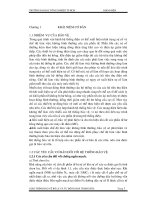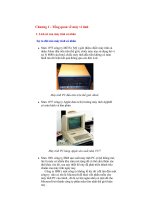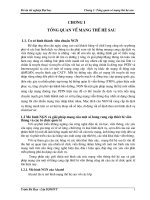geology (1)
Bạn đang xem bản rút gọn của tài liệu. Xem và tải ngay bản đầy đủ của tài liệu tại đây (1.84 MB, 22 trang )
Geology Study Guide
(Cornell on SNB pp. 35 & 36)
1. Rock that forms from molten material is ……… rock.
Geology Study Guide
(Cornell on SNB pp. 35 & 36)
1. Rock that forms from molten material is ……… rock.
Igneous
Geology Study Guide (Cornell on SNB pp. 35 & 36)
2. Rock that forms from erosion and deposition is ……… rock.
Geology Study Guide
(Cornell on SNB pp. 35 & 36)
3. A river eroding rock into sand may help to produce …… rocks.
River
(wears-away)
erodes rock.
Geology Study Guide
(Cornell on SNB pp. 35 & 36)
4. When an existing rock is changed by heat and pressure it becomes…..
5. Melting, erosion, deposition, heat, and pressure are the process of
the…
Geology Study Guide
(Cornell on SNB pp. 35 & 36)
6. A series of processes on and beneath Earth’s surface that slowly
changes rocks from one kind to another is the ……
7. A rock’s age compared to other rocks is its …..
8. The number of years since a rock formed is its ….
Test Questions:
Which rock is
Oldest?
Which rock is
youngest?
9. Index fossils are useful because they tell the relative ages of the rock
layers in which they occur.
10. Some elements break down or decay releasing particles and energy in
a process called …….
11. Comparing the ratio of radioactive atoms to daughter atoms to
determine the age of a rock is called…..
12. Some scientist think life began before 3 billion years ago due to
radioactive dating stromatolite fossils.
13. Radioactive dating determines a rock’s absolute age.
14. Inferred from moon rocks, scientists assume the Earth is 4.6 billion
years old.
15. The theory that the pieces of the Earth’s outer layer are in constant
motion is ….
15. The theory that the pieces of the Earth’s outer layer are in constant
motion is ….
Plate tectonics
.
16. The location of the continents has changed because of the movement
of the Earth’s plates.
17. Knowing the average speed of the Earth’s plates allows inferences to
be made about their past and future.
The San Andreas fault moves an average of 2 inches annually, meaning
Los Angeles will be next to San Francisco in about 15 million years.
The San Andreas fault moves an average of 2 inches annually, meaning
Los Angeles will be next to
San Francisco
in about
15 million years.
18.
The processes occurring on Earth today are similar to those that occurred
in the past.
19.
The geologic processes occurring on Earth have made large cumulative
effects over long periods of time.









